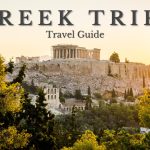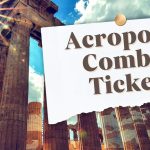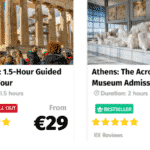Hey! I’m on vacation in Greece and I’ve been to Santorini, but I’ve got lots of more cool stuff that I didn’t get to. So check out this guide for my top 10 things to do in Santorini
Things to do in Santorini that we suggest
1. Santorini: Volcanic Islands Cruise with Visit to Hot Springs
Sail from Athinios Port to tiny islands with volcanoes, hot springs, and traditional settlements.
Stop at Nea Kameni and follow the trail to the active volcano’s crater.
Take advantage of your free time to explore the island. After that, go to Palea Kameni and swim in the hot springs.
Return aboard the boat for a quick voyage to Thirassia, where you’ll have time to explore.
Visit Manolas, which may be reached by winding steps or a donkey ride up to the village. The excursion may be extended at Oia to take in the panoramic vistas and a stunning sunset.
This option is available from May 1 through September 21. The trip lasts 6 or 10 hours, depending on the package picked.
If you choose this option, you will be moved to Oia at the conclusion of the boat voyage. Please meet your bus at the designated meeting location 15 minutes after dusk.
2. Santorini: Romantic Catamaran Cruise for Small Groups
Take a leisurely catamaran trip during the day for beautiful views or a nighttime cruise for a romantic ambiance.
If you take the morning cruise, you’ll set out from Ammoudi Bay at 10:00 a.m. to the island’s famed caldera, where you’ll enjoy a soothing dip in its warm springs.
Return to the boat and proceed towards Aspronisi Island, taking in views of Indian Rock and the Venetian Lighthouse along the way.
The journey continues with a visit to Mesa Pigadia Beach, which provides a picturesque setting for a Greek barbeque lunch.
After your dinner, view the vermilion sands of Red Beach and go for a dip in the Aegean Sea’s turquoise waves before concluding your voyage at Vlychada Marina.
3. Santorini: Catamaran Cruise with Fresh BBQ & Drinks
Take a 5-hour sunset sail around Santorini in the Aegean Sea on the 74-foot Ocean Voyager or the 80-foot Tahiti catamaran.
Set off on an adventure that will lead you first to the hot springs, then to the Red Beach, and ultimately to the White Beach.
You will depart from the Ammoudi Port of Oia or your hotel if you upgrade to add hotel pickup and drop-off service, and sail about 30 minutes to the magnificent Red Beach to swim and snorkel.
Continue to a remote White Beach that can only be reached by boat for additional swimming and snorkeling in the shade of the towering white cliffs.
Enjoy a barbeque meal on the catamaran, complete with salads and grilled meat and vegetarian choices.
Continue cruising within the crescent-shaped Caldera, near to the volcano, and have one more plunge in the Hot Springs before floating back to Oia as the day comes to a close with a stunning sunset.
4. Catamaran Cruise with Lunch and Open Bar in Santorini
You will sail away from the dock (Vlychada port) toward your first destination of the day, the famed Red Beach.
The enthralling Red Beach, with its vibrant colors and strange rock formations, is certainly a sight to see.
Combine sightseeing with swimming, snorkeling, or just lazing on the beach while you’re here.
You’ll also see the magnificent White Coastline, a brilliant and wild beach coated in limestone, during your trip.
Close by, you’ll find breathtaking views of Akrotiri’s Venetian Lighthouse, a landmark that provides lots of fantastic picture possibilities for everyone.
The Santorini Volcano is your next visit, a volcanic hot spring with medicinal capabilities and a plethora of breathtaking caves and volcanic beaches. Stop at Mesa Pigadia beach, which is widely referred to be Santorini’s best hidden secret.
5. Santorini: Small Group Luxury Catamaran w/ Meal & Open Bar
Set sail on a 5-hour luxury catamaran tour of the Santorini caldera, complete with a wonderful traditional dinner and refreshing beverages from the open bar.
Sail on a cruise with a limit of 20 persons in the morning or at dusk, or upgrade to a private cruise experience.
Relax as you are driven directly to the dock after being picked up from your hotel.
Take advantage of the snorkeling opportunities by stopping for a half-hour off the coast of Red Beach, followed by 1.5 hours snorkeling in the sea caves of White Beach.
Bathe in the hot springs of the lagoon and snorkel in the pristine waters.
Taste the tastes of Greece as you dine on a selection of native Santorini specialities for lunch or supper, depending on the time of day, including meat and vegetarian choices.
6. Sunset Dinner Cruise on the Santorini Volcano and Thirassia
Benefit from hotel pickup and then travel to Athinios Port to board a boat.
Cruise to the island of Nea Kameni and ascend to the summit of the volcano.
Continue to Palia Kameni to dive and swim in the hot springs formed by the volcano’s underwater capabilities.
Sail over the underwater craters to Thirasia Island, where you may relax with a supper buffet of pork rolls, chicken rolls, rice and baked potatoes, Greek salad, tzatziki, bread, and seasonal fruit, all served with local wine.
Set sail as the sun starts to set into the sea and immerse yourself in the genuine romanticism of Santorini from the ocean.
7. Horseback Riding from Vlychada to Eros Beach in Santorini
Begin your horseback riding experience by having a professional teach you the fundamentals and supply you with all of the essential equipment.
After beginning your tour in the magnificent dunes of Caldera Beach, you’ll be led to the Santorini highlands to observe nature’s pristine beauty while taking in panoramic views of the Aegean Sea and local culture.
Your course will next take you to Eros’s dark beach, where you’ll ride down the coastline, dipping in and out of the water’s edge.
You’ll be able to stop here and snap shots of the surrounding area, as well as admire the lovely sand dunes. Finally, you’ll return to your stable on a path that will lead you back to where you started, but with memories that will last a lifetime.
8. Santorini’s Majestic Spots by Island Bus
Begin with the breathtaking view from the Prophet Elias Monastery and then go to the lovely monastery.
Then, visit Pyrgos village, one of the most scenic on the island.
Continue to the Akrotiri Excavations, one of the most important archaelogical sites in the region.
Akrotiri is a massive building that was originally home to 200 households and was preserved by the volcano’s lava.
Then you will have around 40 minutes of free time at Red Beach to just appreciate the beautiful formations of the mountains and/or visit Akrotiri Bay for coffee or lunch with Greek traditional mezedes and ouzo (not included in the price).
Following that is Fira town, the island’s capital, where a trip around will allow you to capture stunning photos of the Caldera.
Shop or dine on authentic Santorinian fare. The last destination is Oia village, which is home to the world’s most renowned sunset.
9. Santorini: Small Group Wine Tasting Tour (4 Hours)
Visit the most prestigious wine estates on the island of Santorini and taste 12 different wines made by local vineyards.
Learn about the volcanic island’s 3,500-year history of winemaking, beginning with a vineyard planted on the peculiar soils with traditional basket vines.
Learn about the local viticulture that has helped to make Santorini a UNESCO World Heritage Site for wine production.
Visit three unique wine estates: Argyros Estate or Art Space Winery, Koutsoyannopoulos Wine Museum, Venetsanos Winery, or Gavalas Estate Winery.
Organic wines such as Nykteri, Assyrtiko, and Vinsanto are paired with local delights like as cheese and olives.
10. All-Inclusive Luxury Catamaran Small Group Cruise in Santorini
Explore the stunning blue Mediterranean seas of the Santorini Caldera on the brand new Lagoon 450 catamaran, which has cutting-edge technology and luxurious facilities.
The fee includes a round-trip minibus service from your accommodation.
The first stop on the 5-hour trip will be a half-hour visit to Red Beach, so called for its red sand.
Return to the sailboat after some relaxing swimming and wonderful snorkeling and proceed to White Beach, which has similarly dramatic rock hues and more fantastic swimming and snorkeling.
Following the swim, the team will offer a fantastic barbeque dinner aboard.
After that, enjoy the views from the beach before cruising by the magnificent uninhabited islands of Aspronissi and Akrotiri. The last stop on the trip will be at the hot springs for 30 minutes of relaxation.
Santorini the biggest island
It is the biggest island in a tiny, circular archipelago of the same name, which is the remains of a volcanic crater.
It is the southernmost member of the Cyclades group of islands, with an area of around 73 km2 (28 sq mi) and a population of 15,550 according to the 2011 census.
The populated islands of Santorini and Therasia, as well as the uninhabited islands of Nea Kameni, Palaia Kameni, Aspronisi, and Christiana, are all part of the municipality of Santorini.
The entire land area is 90.623 square kilometers (34.990 sq mi).
Thira is the regional unit that includes Santorini.
Santorini is one of the most massive volcanic
The Santorini was the location of one of the most massive volcanic eruptions in recorded history, the Minoan eruption (also known as the Thera eruption), which happened about 3,600 years ago during the height of the Minoan civilisation.
The eruption created a huge crater encircled by hundreds of meters of volcanic ash deposits.
It may have indirectly contributed to the demise of the Minoan civilisation on the island of Crete, 110 kilometers (68 miles) to the south, through a massive tsunami.
Another prominent idea argues that the mythology of Atlantis originated with the Thera eruption.
It is the most active volcanic center in the South Aegean Volcanic Arc, but it is mostly a water-filled caldera today.
The volcanic arc is around 500 kilometers (300 miles) long and 20 to 40 kilometers (12 to 25 miles) broad.
Though volcanism on Thera started approximately 2 million years ago with the ejection of dacitic lavas from vents near Akrotiri, the area first became volcanically active around 3–4 million years ago.
The name
The Latin Empire called Santorini in the thirteenth century in honor of Saint Irene, from the name of the medieval church in the hamlet of Perissa.
The name Santorini is a contraction of the name Santa Irini.
Previously, it was known as Kallst (, “the most beautiful one”), Strongl (o, “the round one”), or Thra.
The name Thera was reintroduced as the official name of the island and its principal city in the eighteenth century, although the colloquial name Santorini is still widely used.
History Akrotiri, Minoan
Excavations at the Akrotiri site, which began in 1967 under the late Professor Spyridon Marinatos, have rendered Thera the best-known Minoan site outside of Crete, the culture’s birthplace.
At the time, the island was not known as Thera.
Only the southern part of a massive town has been discovered, but it has revealed complexes of multi-level houses, streets, and squares, as well as the ruins of walls as tall as eight meters, all encased in the hardened ash of Thera’s renowned eruption.
The site was not a palace-complex like those discovered in Crete, but it was also not a collection of merchants’ storage, as shown by its good brickwork and beautiful wall-paintings.
A loom-workshop advises that textile weaving be structured for export.
Bronze Age
This Bronze Age culture flourished between 3000 and 2000 BC, peaking between 2000 and 1630 BC.
Many of the residences in Akrotiri are substantial constructions, some of which are three storeys tall.
Its streets, squares, and walls were preserved in the ejecta layers, which were sometimes as tall as eight meters, showing that this was a significant town.
Many homes still have stone stairs that store big ceramic storage jars (pithoi), mills, and ceramics.
The most notable archaeological relics discovered at Akrotiri are wall murals or frescoes that have retained their original color despite being buried under several metres of volcanic ash.
The town also had a well-developed drainage system, and the exquisite artwork indicated that its residents were undoubtedly smart and quite rich.
Akrotiri’s pipes with flowing water and water closets are the earliest such facilities identified.
[Citation required] The pipes are dual systems, showing that Therans employed both hot and cold water sources; the hot water’s source was most likely geothermic, given the volcano’s closeness.
According to Charles Pellegrino
According to Charles Pellegrino, the twin pipe system, complex construction, and apparent layout of the Akrotiri discovery reflect Plato’s description of the mythical lost city of Atlantis, indicating the Minoans as the civilisation that originally inspired the Atlantis tale.
Akrotiri’s fragmentary wall paintings lack the forceful religious or mythical substance seen in Classical Greek décor.
Instead, the Minoan paintings show “Saffron-Gatherers” presenting crocus-stamens to a sitting woman, maybe a deity.
Crocus has been shown to offer a variety of medical properties, including the treatment of menstruation discomfort.
Many[who?]
Many[who?] archaeologists think that the saffron/crocus gatherers fresco is a coming-of-age painting dealing with female pubescence.
Among other frescoes in another house are two antelopes painted with a confident, flowing, decorative, calligraphic line, the famous fresco of a fisherman with his double strings of fish strung by their gills, and the flotilla of pleasure boats, accompanied by leaping dolphins, where ladies take their ease in the shade of light canopies.
The ancient town’s well-preserved remains are sometimes compared to the stunning ruins at Pompeii in Italy.
September 2005
In September 2005, the canopy that covered the remains fell in an accident, killing one visitor and injuring seven others.
The facility was closed for almost seven years while a new cover was constructed. In April 2012, the facility reopened.
The earliest signs of human settlement are from the Late Neolithic.
(4th millennium BC or earlier), but between 2000 and 1650 BC.
Akrotiri developed into one of the Aegean’s major Bronze Age ports, with recovered objects from not only Crete.
But also Anatolia, Cyprus, Syria, and Egypt, as well as the Dodecanese and the Greek mainland.
The Bronze Age eruption was dated.
Ancient Thera Stoa Basilica
Because evidence of the eruption appears across the area and the site itself includes material culture from outside, the Minoan eruption gives a fixed point for the chronology of the second millennium BC in the Aegean.
The eruption took place during the “Late Minoan IA” era on Crete and the “Late Cycladic I” period on the surrounding islands.
Based on the recognized chronology of Bronze Age Mediterranean civilizations, archaeological evidence places the eruption about 1500 BC.
These dates, however, contradict radiocarbon dating, which shows that the eruption took place between 1645 and 1600 BC.
The date of the eruption is debated for these and other reasons.
 Before you buy tickets, read the guide for 2024. Click Here
Before you buy tickets, read the guide for 2024. Click Here


